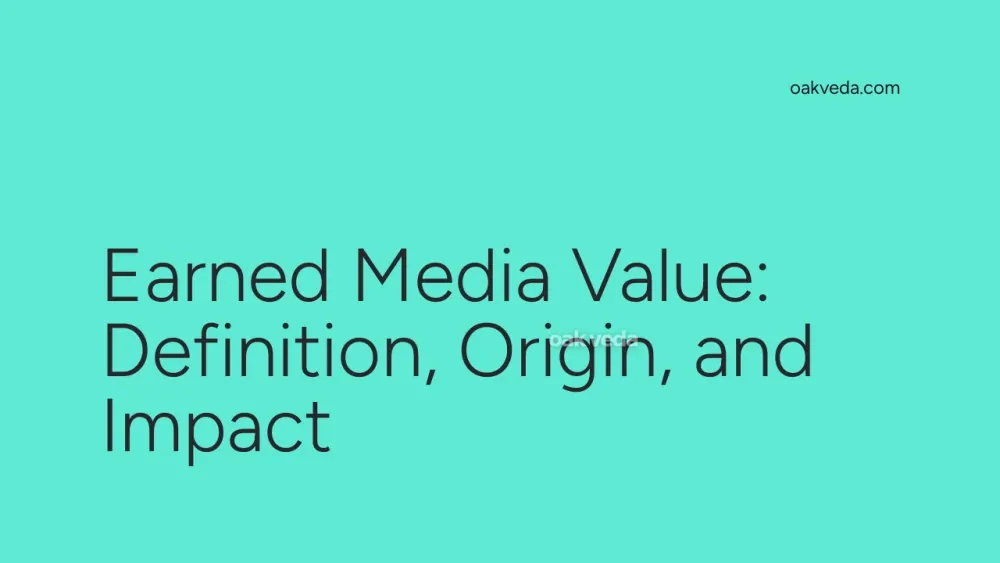
What is Earned Media Value?
Earned Media Value (EMV) is a key metric in digital marketing that estimates the monetary worth of organic brand exposure across various channels. This includes social media interactions, press coverage, word-of-mouth recommendations, and other forms of unpaid publicity. EMV helps businesses quantify the impact of their non-paid marketing efforts, providing insights into the effectiveness of their overall marketing strategy.
Origin and Development of Earned Media Value
The concept of EMV emerged as social media platforms gained prominence in the early 2010s. Marketers needed a way to measure the value of organic engagement, which was becoming increasingly important in the digital landscape. As traditional advertising methods became less effective, brands recognized the power of earned media in building trust and credibility with their audience.
How Earned Media Value Works
EMV works by assigning monetary values to different types of organic engagements. These can include:
- Social media likes, shares, and comments
- Mentions in press articles
- Customer reviews
- Influencer collaborations
- User-generated content
By calculating the estimated value of these interactions, brands can better understand the return on investment (ROI) of their marketing efforts and compare the effectiveness of different campaigns or strategies.
How to Calculate Earned Media Value
There are two primary methods for calculating EMV:
-
Manual Formula: This approach involves assigning a specific monetary value to each type of engagement. For example:
- $0.50 per like
- $5 per share
- $10 per comment
The formula would then be: EMV = (Number of Likes × Value per Like) + (Number of Shares × Value per Share) + (Number of Comments × Value per Comment)
-
Automated Tools: Platforms like Later Influence use more sophisticated methods, such as the Ayzenberg Earned Media Value Index. These tools consider factors like platform demand and content type to provide more accurate and dynamic EMV calculations.
Impact of Earned Media Value on Social Media Culture
EMV has significantly influenced social media culture by:
-
Encouraging authentic engagement: Brands focus on creating content that naturally resonates with their audience, leading to more genuine interactions.
-
Empowering influencers: EMV helps influencers demonstrate their value to potential brand partners, fueling the growth of influencer marketing.
-
Shifting marketing priorities: Companies now allocate more resources to creating shareable, engaging content rather than relying solely on paid advertising.
-
Fostering transparency: As consumers become more aware of EMV, they expect brands to be more transparent about their marketing practices.
How Brands and Influencers Use Earned Media Value
Brands leverage EMV in several ways:
-
Campaign evaluation: EMV helps measure the success of marketing campaigns by quantifying organic reach and engagement.
-
Influencer selection: Brands use EMV to identify influencers who can generate the most valuable organic exposure.
-
Content strategy optimization: By analyzing which types of content generate the highest EMV, brands can refine their content strategy.
-
Competitive analysis: Companies compare their EMV to competitors to gauge their relative market position.
Influencers use EMV to:
-
Demonstrate value: High EMV helps influencers negotiate better partnerships with brands.
-
Refine content strategy: Understanding which posts generate the highest EMV allows influencers to create more impactful content.
-
Diversify platforms: EMV calculations across different platforms help influencers decide where to focus their efforts.
Future Trends Related to Earned Media Value
As the digital landscape evolves, several trends are shaping the future of EMV:
-
AI-powered EMV calculation: Advanced algorithms will provide more accurate and real-time EMV estimates.
-
Integration with other metrics: EMV will be increasingly combined with other KPIs for a more holistic view of marketing performance.
-
Focus on micro-moments: Brands will pay more attention to small but significant interactions that contribute to overall EMV.
-
Emphasis on long-term value: There will be a shift towards measuring the sustained impact of earned media over time, rather than just immediate engagement.
-
Cross-platform EMV: As users engage across multiple platforms, EMV calculations will become more sophisticated in tracking cross-platform interactions.
FAQs about Earned Media Value
-
Is EMV more important than paid advertising? While EMV is crucial, a balanced approach using both earned and paid media is often most effective.
-
How accurate are EMV calculations? Accuracy varies depending on the method used. Automated tools using dynamic indices tend to be more precise than static formulas.
-
Can EMV be negative? While EMV itself is not negative, negative publicity can result in a decrease in overall EMV.
-
How often should EMV be calculated? For most brands, monthly or quarterly EMV calculations provide sufficient insights, but some may benefit from more frequent analysis.
-
Does EMV apply to B2B companies? Yes, EMV is relevant for B2B companies, especially when considering industry publications, professional networks, and thought leadership content.
In conclusion, Earned Media Value has become an essential metric in the digital marketing landscape. By quantifying the impact of organic engagement, EMV helps brands and influencers make data-driven decisions, optimize their strategies, and demonstrate the true value of their online presence. As social media continues to evolve, EMV will undoubtedly play a crucial role in shaping marketing strategies and measuring success in the digital realm.
You may be interested in:
- Creator Economy: Definition, Origin, and Impact
- Fire: Definition, Origin, and Impact in Social Media
- Social Media Monitoring: Definition, Origin, and Impact
- SMH: Definition, Origin, and Impact on Social Media
- YouTube Shorts: Definition, Origin, and Impact
- Vanity Metrics: Definition, Origin, and Impact on Social Media

